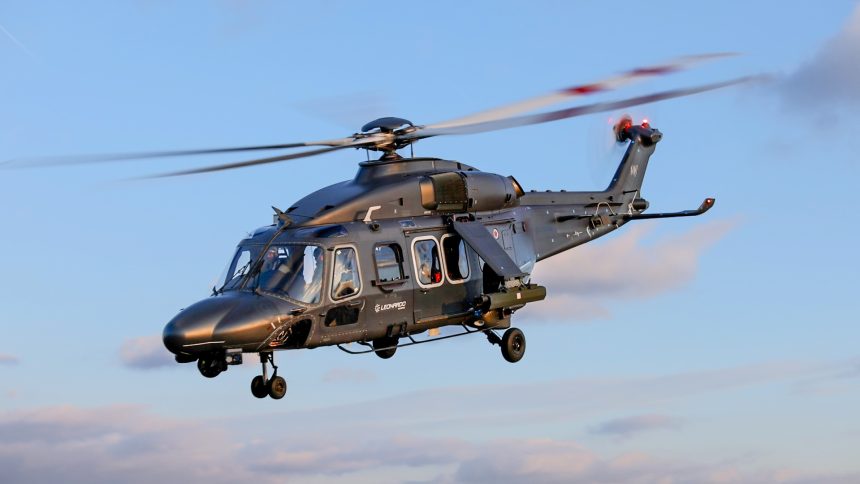Modern, modular, and NATO-ready, the AW149 is emerging as Europe’s next generation medium multirole helicopter built for the modern battlefield.
Building on Leonardo’s extensive experience in the military helicopter sector, the AW149 is becoming increasingly popular as a latest generation medium multi-role helicopter in the 8-9-ton class. In less than two decades, the Leonardo AW149 has gone from concept to front‑line service, carving out a reputation as a highly survivable, militarily capable and, especially in recent years, internationally sought‑after platform.
Fresh of the win of a procurement contract for the Malaysian government, the AW149 is being marketed as the ideal solution for the UK’s New Medium Helicopter program, for which Leonardo is the sole bidder. The helicopter also recently entered service in Poland, the first European operator of the type.
In the days preceding this year’s edition of the Royal International Air Tattoo, The Aviationist had a chance to attend a briefing with Leonardo Helicopters focused on the AW149.
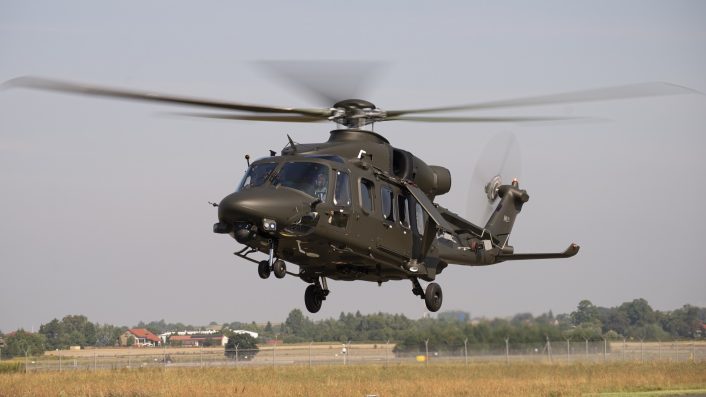
Leonardo AW149
The AW149 is a medium helicopter, which can be employed in different tactical scenarios based on the latest military requirements. At the same time, the AW149 follows design and engineering philosophies which allow the helicopter to be interoperable with all assets involved in today’s rapidly evolving scenarios, with a forward-looking focus on multi domain operations.
The AW149 was born with the multi-role capability in mind, especially with a large unobstructed cabin which can be rapidly and easily reconfigured to support different roles. Avionics and communications, including Situational awareness and tactical scenario representation, are also another focus, with potential for continuous growth as technology and requirements changes.
The helicopter completes Leonardo’s military medium helicopter offer, joining the lighter AW169M and AW139M. The AW149 obtained an important commercial success in recent times, with orders and interest demonstrated around the world.
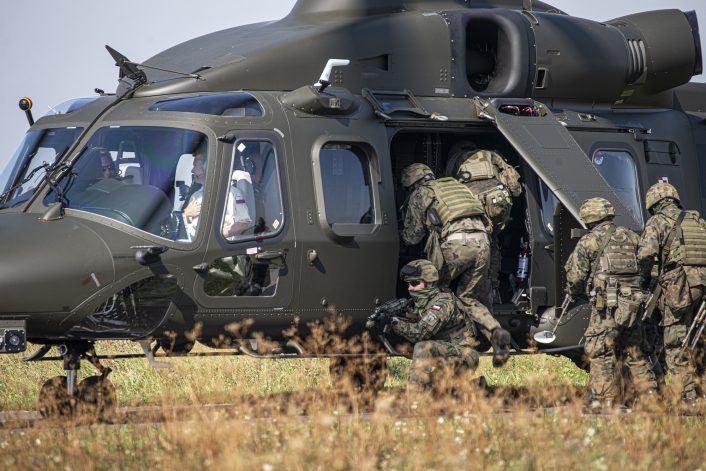
Multi-role medium helicopter
The AW149 has a maximum take-off of 8,600 kg, with a large 11.2 cubic meters cabin which can carry 16 fully kitted troops. The helicopter is rated for both single and dual pilot operation in VFR and IFR conditions, day and night.
As for most military helicopters, the AW149 is NVG-ready (Night Vision Googles) and equipped with IR formation light for night tactical operations. Similarly, the helicopter is all-weather and can work in desert conditions, with filters for the air intakes, and icing conditions, thanks to an ice protection system, optionally available in a limited and full protection variant.
The helicopter has been thought since the initial design as a multi-role platform. Because of this, the design includes features to allow quick configuration changes without the need for special equipment and specialized personnel, directly on the flight line.
With over 240,000 flight hours accumulated and more than 80 units delivered or on order as of April 2025, the AW149 is steadily gaining traction as a mature and proven design.
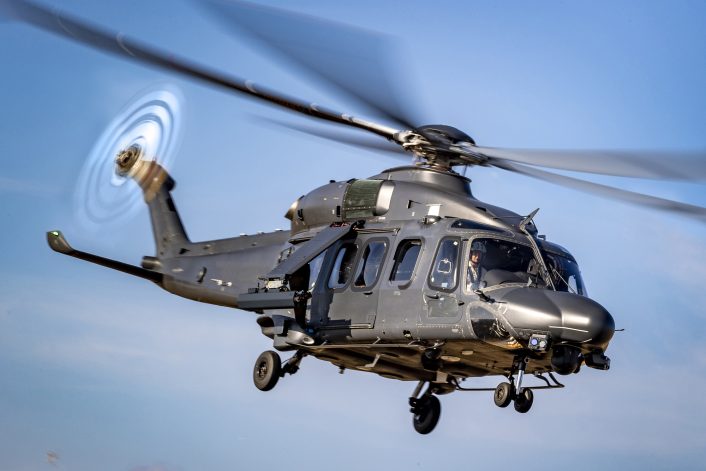
Mission flexibility and modularity
Aerial mission profiles for the AW149 span tactical transport for both regular troops and Special Operations Forces, Search and Rescue (SAR) and Combat SAR, medical evacuation (MEDEVAC) and casualty evacuation (CASEVAC), Close Air Support (CAS), Intelligence, Surveillance and Reconnaissance (ISR), aerial resupply, and Head of State transport.
The helicopter can employ a barycentric cargo hook with a 2.8 tons capability. The hook has two cameras which provide a visual of the load, the hook and the landing gear, which also allow to check the landing gear while landing on unprepared surfaces.
The design enables rapid reconfiguration via mission kits including EO/IR turret, rescue hoist, stretchers, cargo hooks, searchlights, crew served machine guns, and precision armaments like rocket pods and air-to-ground missiles. A dedicated mission console can also be installed in the cabin, able to interface with the systems installed on the helicopter, as well as transmitting data to and receiving data from other assets.
Configuration swaps can occur within hours, supporting agile mission adaptability—a key asset in hybrid conflicts with shifting operational demands.
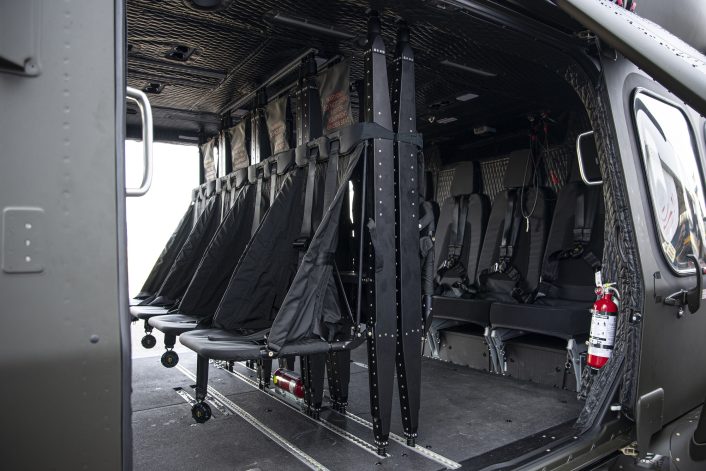
Main features
The AW149 combines robust engineering with battlefield-oriented design features to deliver high levels of survivability, reliability, and mission adaptability. At the core of the platform is a fully articulated main and tail rotor system that enhances stability and gust rejection, which are critical for operations in turbulent or confined environments where military helicopters might operate.
Two General Electric CT7-2E1 engines, supported by a Safran e-APU60 Auxiliary Power Unit, provide ample power and redundancy. As an alternative, the helicopter can employ Safran Aneto-1K engines, based on the customer’s requirement.
A run‑dry-capable main gearbox can sustain operations for 50 minutes, ensuring a safe return to friendly territory and land outside of hostile territory. Compared to other manufacturers, Leonardo says it has added specific procedures in the flight manual for these operations.
The helicopter’s low center of gravity and wide wheel track contribute to excellent ground handling and stability during insertion or extraction on unprepared surfaces. High ground clearance of both main and tail rotors improves safety for disembarking troops and enables deployment in tight landing zones.
A crashworthy and marinized airframe ensures survivability in both land-based and overwater missions. The crashworthiness and survivability have been an important part of the design, as Leonardo documented on its website in a two-part series which described how the helicopter was designed with battlefield survivability in mind.
The spacious 11.2 cubic meters cabin is completely unobstructed, allowing for versatile reconfiguration across transport, CASEVAC, MEDEVAC, or command roles. The cockpit features four large 10×8-inch multifunction displays, fully compatible with night vision goggles (NVG), and integrates a four-axis digital automatic flight control system (AFCS), also with mission profile modes, to reduce pilot workload during complex missions.
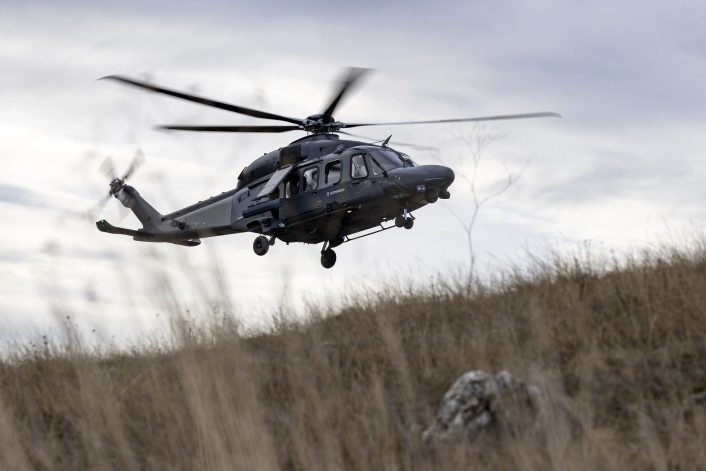
A clean‑sheet military design
The AW149 was engineered from day one as a military asset, not an adaptation of a civilian platform. This differentiates the helicopters from Leonardo’s other military helicopters in the medium class, the AW169M and AW139M, which were developed from the civilian platforms although with a dual-use design in mind.
Some features clearly reflect this strong militarization choice for the AW149, like the high clearance landing gear robustness, the presence of an Auxiliary Power Unit as baseline and the open avionics redundancy. The presence of an APU is an aspect that must not be underestimated, as it allows to sustain self-sufficient operations in remote locations with limited support, in addition to providing increased safety as emergency power backup.
Years later, a civilian 8-9 ton class platform, called the AW189, was developed in response to the market’s need for a super-medium helicopter. The different naming of the two platforms further highlights that, while there is commonality stemming from an originally designed shared platform concept, the two helicopters are different machines under many aspects.
The AW149 features a structurally robust, marinized airframe meeting today’s armed forces standards. Engineered survivability is embedded: critical systems are physically segregated, with redundant systems in opposite positions to have what is called a line clearance. The fuel systems employ self‑sealing tanks, and rotors are ballistically rated to withstand 12.7 mm AP rounds, retaining 90 minutes operation post‑damage.
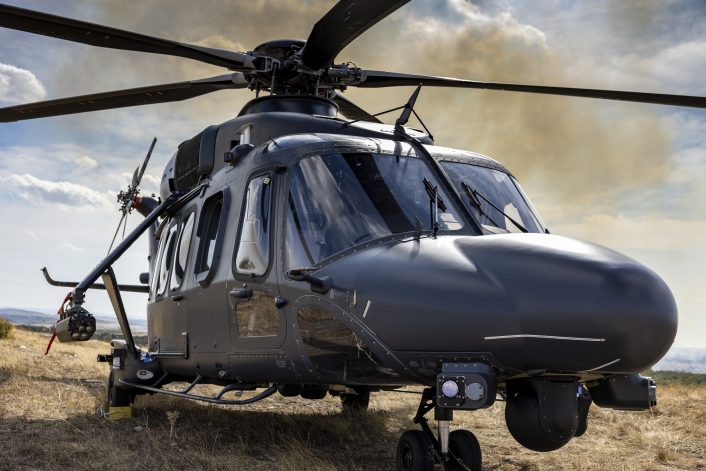
The capabilities
Leonardo positions the AW149 as a high-performance, mission-ready helicopter that meets the evolving operational needs of both NATO and export customers. The aircraft’s value proposition is centered on five key pillars: interoperability, performance, protection, adaptability, and survivability.
Designed to seamlessly integrate into NATO-standard communication and mission networks, the AW149 supports tactical radios, datalinks, and video links—facilitating joint operations across allied forces. Its high power-to-weight ratio enables exceptional payload and endurance performance, even in hot-and-high conditions.
On the battlefield, the AW149 can be configured with a wide range of armaments including HMP400 machine gun pods, rocket pods, and AGM-114 Hellfire air-to-ground missiles, giving it credible fire support capabilities in escort or close air support (CAS) roles. The helicopter can operate with asymmetric armament, or even with armament only on one side, without affecting the center of gravity, which remains in the prescribed limits in every configuration.
Survivability is further enhanced by a comprehensive suite of defensive systems: a full electronic warfare system (EWS), infrared suppression, ballistic protection, and crashworthy architecture allow the platform to operate in denied or high-threat environments. The EWS suite integrates missile, radar, and laser warning receivers, as well as chaff/flare dispensers.
These systems, combined with anti‑spoof GPSs, encrypted comms, and IFF, enable contested‑airspace operations. It also supports complex mission profiles such as fast-roping, aerial surveillance, hoisting operations, and cargo delivery.
A wide range of mission kits are available to customize the helicopter based on mission needs. Among these are Search and Surveillance Radar, EO/IR turret, engines and APU Inlet Barrier Filter, ballistic protections and fast-roping and rappelling systems.
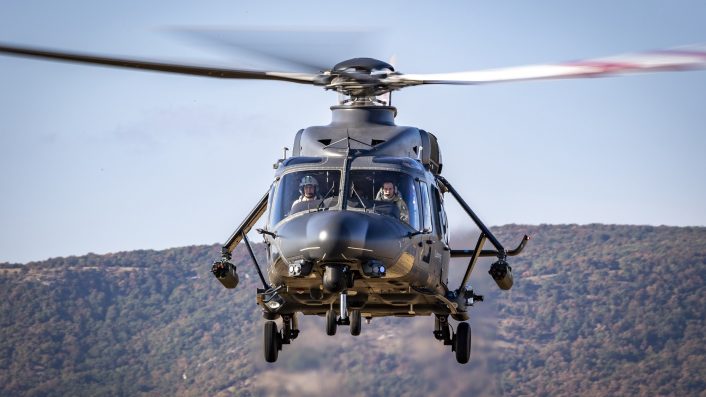
For overwater operations, the helicopter can be equipped with emergency flotation gear, life rafts, maritime transponders (AIS), and direction-finding systems, further broadening its mission envelope. Additionally, SAR modes are available for the autopilot to support SAR operations.
The AW149 is also designed to deliver robust fire support capabilities, with provisions for a wide range of externally mounted weapon systems that enhance its operational effectiveness in combat missions, in addition to 7.62 machine gun pintles. The helicopter is equipped with two external weapon carriers, allowing integration of both guided and unguided munitions depending on mission requirements.
These hardpoints can support HMP400 12.7 mm machine gun pods, 7 and 19 tubes launchers for 70 mm rockets -either guided or unguided – and air-to-ground missiles such as the AGM-114 Hellfire on twin or quadruple rail launchers. Importantly, this weapons integration is supported by the aircraft’s modular open architecture, allowing seamless sensor and targeting system upgrades to align with future threats and mission demands.
Leonardo emphasizes that the AW149 helicopter is the most modern in its class, designed with modern threats and future operational demands in mind. Among the peculiar features, the company mentions a compact external footprint, smaller than older helicopters such as the Black Hawk.
The aircraft’s open-architecture avionics and mission systems offer maximum flexibility for future upgrades or role-specific customization, ensuring long-term relevance and ease of integration with evolving technology. These are developed in-house by Leonardo, making even quicker the introduction of new capabilities.
Safety is a key focus of this machine, integrating safety concepts from both the military and civilian systems. The AW149 benefits from a clean-sheet design that incorporates lessons learned from decades of military helicopter operations.
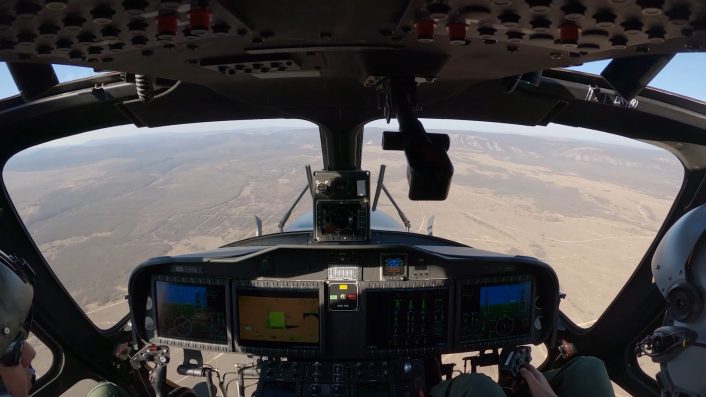
UK New Medium Helicopter
Emerging as the sole contender in the UK’s New Medium Helicopter (NMH) program—following Airbus and Sikorsky’s August 2024 withdrawal—the AW149 is currently at the center of the negotiations between Leonardo and the British Ministry of Defense. The program would procure a fleet of new medium-lift support helicopters , with numbers yet to be confirmed, with one key requirement of NMH being to provide as much value to UK-based industry as possible.
Though long expected previously, the NMH program was officially initiated following the Defence in a Competitive Age command paper published by the UK MoD in 2021. The paper identified the requirement for a new medium lift helicopter to enter service with the British military in the mid 2020s, replacing the Puma HC2, Bell 212, Griffin HAR2 and Dauphin AH1.
The MoD’s Defence Equipment & Support (DE&S) agency, which is in charge of the NMH program, says it is procuring a modern, medium-lift support helicopter which will deliver up to five rotary wing requirements using a single aircraft type, improving efficiency and operational flexibility. Once in service, the helicopter will be capable of operating in all environments in support of a broad spectrum of tasks, from warfighting to humanitarian efforts and operations around the world.
Leonardo earmarked the historic helicopter factory at Yeovil, home of Westland Helicopters, for any UK AW149 order. The company has long maintained that it is the most natural option for a government looking to boost home-grown businesses, utilizing existing facilities and promising that up to 70% of through-life investment for the AW149 would be within the UK.
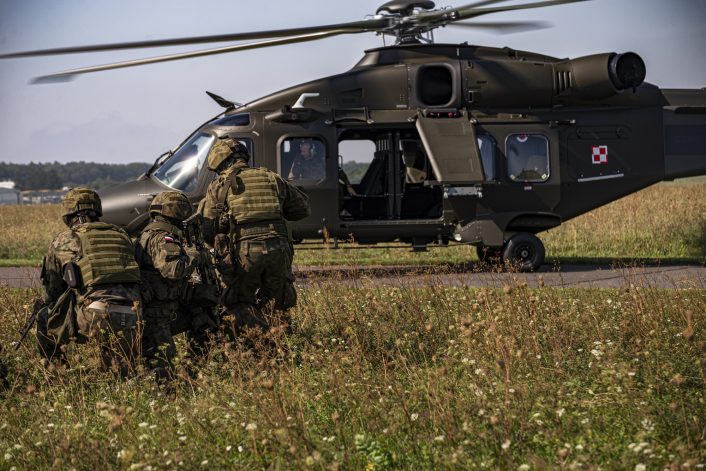
The NMH contract, under the original schedule, was due to be officially awarded in 2025. Leonardo Helicopters could not comment on the program due to the ongoing negotiations, however the most recent reports state that the MoD is currently evaluating Leonardo’s bid, with results still expected by the end of the year.
“Following successful negotiations with the Ministry of Defence, we have submitted our ‘best and final offer’ for the New Medium Helicopter programme,” said to Flight Global Nigel Colman, managing director of Leonardo Helicopters UK. “Our bid, to offer the AW149 helicopter made at the Home of British Helicopters in Yeovil, fulfils the immediate capability requirements of the UK armed forces and will maintain a vital part of our onshore defence industrial base. We are also confident that our offer represents value for money in sustaining British jobs, skills, innovation and growth.”
The DE&S confirmed the ongoing evaluation, saying Leonardo’s proposal “will be evaluated through 2025 when, subject to government approvals, a contract award is anticipated”.
Should the UK embrace the AW149, the helicopter would gain another prestigious NATO user, reinforcing interoperability and encouraging collaborative doctrine. A selection by the UK MoD would provide important credentials for the helicopter, and its international reach could pave the way for new opportunities.
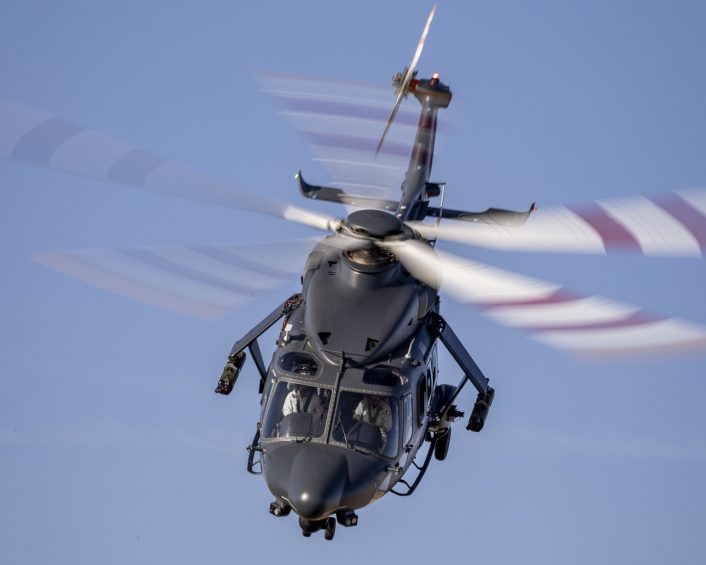
Export success
Although Italy hasn’t placed orders yet for the type, focusing so far on fleet modernizations plans driven by other weight/size category aircraft like the AW169M and AW139/AW139M consistent with ageing types to be gradually replaced, the AW149 has progressively obtained growing export success instead, with specific qualifications delivered by countries which have selected the type meeting their specific customization needs.
Egypt became the first confirmed operator, placing an order for 24 helicopters in 2019. Italian Government’s documents mention the export authorization in 2019 for a package of 32 helicopters, of which 24 were AW149s and the remaining eight were AW189s. Web sources indicate initial deliveries took place between late 2020 and early 2021, validating the platform’s performance in demanding conditions.
In Poland, a major procurement milestone was reached in July 2022, when the Ministry of National Defense signed a contract valued at PLN 8.25 billion (approximately €1.76 billion) for 32 AW149 helicopters. The deal included not only airframes, but also training systems, simulators, logistics support, and a full suite of mission equipment. Just 15 months later, in October 2023, the first two aircraft were formally accepted into service by the 25th Air Cavalry Brigade.
Leonardo further expanded its industrial footprint in Poland by opening a dedicated AW149 production line at PZL-Świdnik in June 2024. The facility now serves as the primary manufacturing hub for future Polish airframes and, by February 2025, the first AW149 fully built in Świdnik rolled off the line.
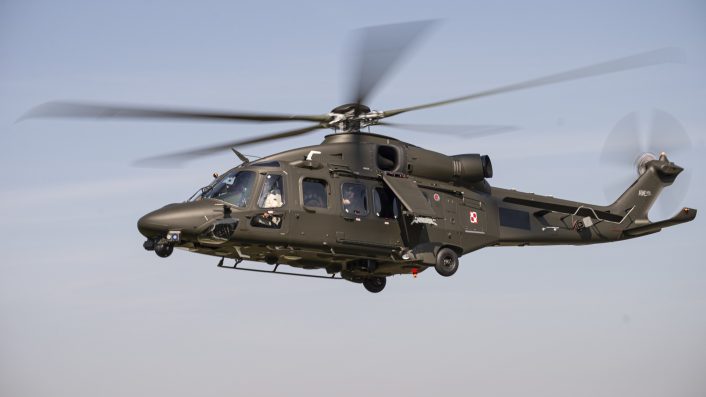
North Macedonia has committed to acquiring four AW149, as part of a broader modernization effort that also includes four AW169Ms. The total package, valued at approximately €330 million according to various sources although Leonardo did not confirm this information, is aimed at replacing the country’s ageing Mi-8/17 and Mi-24 helicopter fleet.
The AW149 was selected following a competitive evaluation process in early 2024, where it emerged because of its flexibility, logistical support package, and cost-effectiveness. The procurement contract was formally signed in March 2024, with deliveries expected to begin in mid-2026
Malaysia announced at LIMA 2025 an ambitious helicopter modernization also involving the AW149. Although the value was not confirmed by Leonardo, the deal is said to be valued at approximately RM 16.5 billion (~USD 3.4 billion) by various Malaysian media sources and covers a 15‑year lease of up to 28 helicopters by Weststar, also including AW149s, operated through Weststar Aviation Services, with deliveries slated for 2026–2027.
Under this arrangement, among the different models, the programme also comprises AW149 helicopters for the Royal Malaysian Air Force and the Royal Malaysian Army, for Combat Search and Rescue, Troop Transport and utility applications.
The Aviationist would like to thank Head of Product Marketing and Sales Engineering Carlo Sacco and VP for Marketing at Leonardo Helicopters Giacomo Zampetti for the opportunity to join the briefing about the AW149 and the help provided in the preparation of this article.

